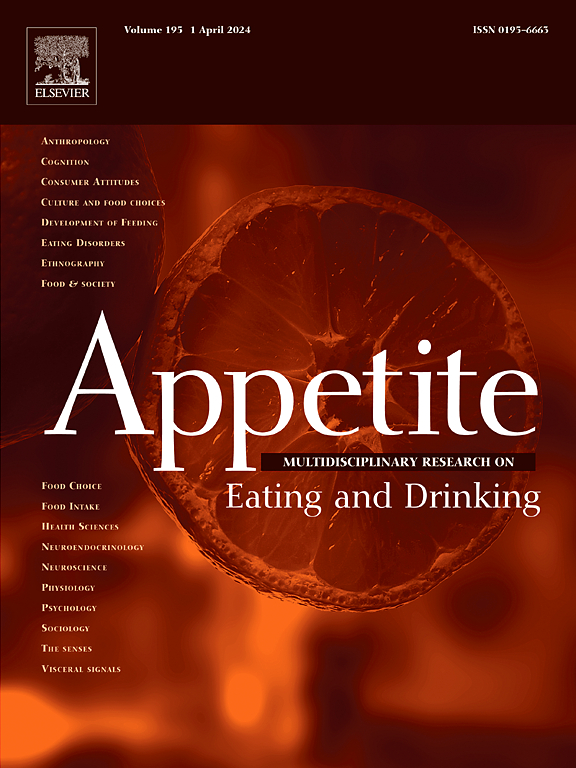Metabolic profile of healthy, normal-weight adults with low satiety responsiveness
IF 4.6
2区 医学
Q1 BEHAVIORAL SCIENCES
引用次数: 0
Abstract
The aim of this study was to characterize the metabolic profile of healthy, normal-weight adults presenting with low satiety responsiveness. Individuals were categorized with low or high satiety responsiveness (LSR and HSR, respectively) based on the satiety quotient (SQ), a marker of satiety responsiveness, which was calculated following two isocaloric breakfast test meals offered while participants were inside the whole-room indirect calorimeter (WRIC): 1) North American: 55 % carbohydrate, 15 % protein, and 30 % fat; 2) High-protein: 31 % carbohydrate, 43 % protein, and 26 % fat. Following the North American breakfast, participants continued receiving a diet resembling the North American dietary pattern while inside the WRIC for 32 consecutive hours where the following outcome measures were assessed: energy metabolism components, metabolic blood markers, and appetite sensations. Forty-three participants were included; 13 were classified as LSR (n = 3 females; n = 10 males), n = 16 as HSR (n = 10 females; n = 6 males), and n = 14 were uncategorized. Compared with HSR, individuals with LSR had higher body weight (5.4 ± 2.5 kg; P = 0.042) and waist circumference (LSR: 77.5 (7.6) cm; HSR: 70.7 (5.2) cm; P = 0.012). Participants with LSR presented with higher total energy expenditure (184 ± 85 kcal/day; P = 0.040) and carbohydrate oxidation rate (34 ± 13 g/day; P = 0.015). Moreover, individuals in the LSR category presented with weakened satiety response to the meals when compared to those with HSR. Our primary findings were that, compared to individuals with HSR, those in the LSR category exhibited differences in their metabolic profile. The long-term impact on body weight and overall health should be assessed in further studies.
低饱腹反应的健康、正常体重成人的代谢谱
本研究的目的是表征健康、正常体重的成年人低饱腹感反应的代谢特征。根据饱腹感商数(SQ)将个体分为低饱腹感反应性和高饱腹感反应性(分别为LSR和HSR),饱腹感商数是一种饱腹感反应的标志,是在参与者在全室间接量热计(WRIC)内提供的两顿等热量早餐测试餐后计算得出的:1)北美:55%碳水化合物,15%蛋白质和30%脂肪;2)高蛋白:碳水化合物31%,蛋白质43%,脂肪26%。在北美早餐之后,参与者继续接受类似北美饮食模式的饮食,同时在wrc内连续32小时,评估以下结果指标:能量代谢成分,代谢血液标志物和食欲感觉。共纳入43名受试者;LSR 13例(女性3例;n=10男性),n=16为高铁(n=10女性;N =6男性),N =14未分类。与HSR患者相比,LSR患者的体重高于HSR患者(5.4±2.5 kg);P=0.042)和腰围(LSR: 77.5 (7.6) cm;高铁:70.7 (5.2)cm;P = 0.012)。LSR组的参与者表现出更高的总能量消耗(184±85千卡/天);P=0.040)和碳水化合物氧化率(34±13 g/d);P = 0.015)。此外,与高满意度的个体相比,低满意度的个体对食物的饱足反应较弱。我们的主要发现是,与HSR个体相比,LSR类别的人在代谢谱上表现出差异。对体重和整体健康的长期影响应在进一步的研究中进行评估。
本文章由计算机程序翻译,如有差异,请以英文原文为准。
求助全文
约1分钟内获得全文
求助全文
来源期刊

Appetite
医学-行为科学
CiteScore
9.10
自引率
11.10%
发文量
566
审稿时长
13.4 weeks
期刊介绍:
Appetite is an international research journal specializing in cultural, social, psychological, sensory and physiological influences on the selection and intake of foods and drinks. It covers normal and disordered eating and drinking and welcomes studies of both human and non-human animal behaviour toward food. Appetite publishes research reports, reviews and commentaries. Thematic special issues appear regularly. From time to time the journal carries abstracts from professional meetings. Submissions to Appetite are expected to be based primarily on observations directly related to the selection and intake of foods and drinks; papers that are primarily focused on topics such as nutrition or obesity will not be considered unless they specifically make a novel scientific contribution to the understanding of appetite in line with the journal's aims and scope.
 求助内容:
求助内容: 应助结果提醒方式:
应助结果提醒方式:


